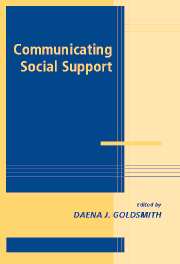Book contents
- Frontmatter
- Contents
- Acknowledgments
- Introduction
- 1 Puzzles in the Study of Enacted Social Support
- 2 Conceptualizing Enacted Support as Communication
- 3 Communicating Advice
- 4 Reexamining Matching Models of Social Support
- 5 Problematizing Provider/Recipient Roles in Troubles Talk
- 6 Conclusions and Implications
- Appendix
- References
- Index
Appendix
Published online by Cambridge University Press: 27 March 2010
- Frontmatter
- Contents
- Acknowledgments
- Introduction
- 1 Puzzles in the Study of Enacted Social Support
- 2 Conceptualizing Enacted Support as Communication
- 3 Communicating Advice
- 4 Reexamining Matching Models of Social Support
- 5 Problematizing Provider/Recipient Roles in Troubles Talk
- 6 Conclusions and Implications
- Appendix
- References
- Index
Summary
Here I provide additional information about the participants, procedures, and measures employed in various studies that are reported in this book. For the reader's ease of reference, I have listed the studies alphabetically according to the label given in the text (rather than chronologically).
ADVICE CONTENT STUDY
A sample of 233 University of Illinois undergraduate students completed a questionnaire during the last 10 minutes of their speech communication class or during a meeting at their fraternity. Some questionnaires were incomplete and others were randomly discarded to achieve an equal number of men and women in each of the cells of the study design. Results were based on 186 participants. Our sample included 66.5% European Americans, 15.5% African Americans, and 8.6% Asian Americans. The remaining students were members of other racial-ethnic groups or declined to indicate their racial-ethnic identity. The mean age of respondents was 19.6 years. Most students were sophomores or juniors and half were speech communication majors.
Each student read a narrative about a student named Pat whose sex varied to match the respondent's sex. In the story, Pat was very nervous about giving a speech in class the next day. He/she encountered a friend in the library and mentioned being nervous about the speech. In the course of their conversation, the friend delivered the message that respondents were then asked to rate. Each respondent read a single message, selected from messages produced by a different sample of students in the Naturalistic Experiment study.
- Type
- Chapter
- Information
- Communicating Social Support , pp. 165 - 172Publisher: Cambridge University PressPrint publication year: 2004
- 2
- Cited by

